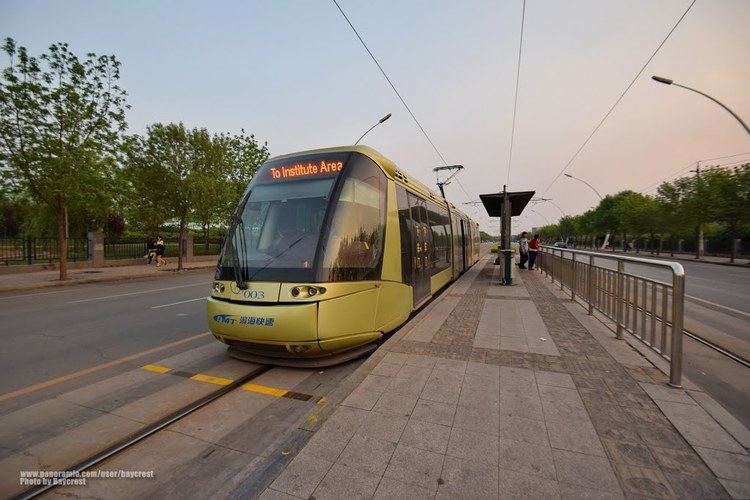Status Operational Stations 14 Electrification Overhead line | Owner Tianjin | |
 | ||
Termini TEDANorth of College District | ||
TEDA Modern Guided Rail Tram is a Translohr Light Rail system in Tianjin Economic-Technological Development Area. It is a modern, high speed rubber tired tram system, both first in China & Asia. The line is considered as part of the Tianjin Metro system.
Contents
Tianjin once had a conventional steel-wheeled tramway network. The system gradually expanded and reached its peak in 1933 with 116 tramcars. Later however, like most cities around the world, the tram service was abandoned in 1972 due to its inefficiency.
Trams returned in Tianjin in 2006. Commercial service started in 2007. Unlike standard tramway, the Translohr rubber-tired LRT system was adopted.
History
After the abandonment of the tram network in 1972, gasoline or diesel-powered vehicles such as buses, taxis, and private automobiles started choking the streets. Like most Asian countries, China suffered many problems, including pollution, gridlock, and a sudden increase in population etc. Increasing population started increasing urbanization of Tianjin, thus more motor vehicles clogged the streets and increased pollution and worsened gridlock. Metro construction started 2 years before the tramway closure. However, it took 14 years to complete the first line as the construction was interrupted greatly by an earthquake and lack of workers. The city was suffering from congestion unheard of in the days of trams and it needed more metro lines, and fast, but construction costs were high. It was not possible for Tianjin in a short period. Another solution was needed. To solve the problem in a cheaper way, they decided to build an elevated rail system in eastern Tianjin, but although it was cheaper than metro, construction of elevated tracks and stations were also costly. So elevated rail also wasn't the permanent solution. Many cities around the world like Tunis, Sydney, Buenos Aires and Pyongyang were building LRT systems, and like them, Tianjin also planned for the return of trams.
In the 1990s the government looked for a way to decrease pollution as soon as possible. After observation from many cities around the world, the decision was made to reinstate trams in Tianjin. By then number of cars & buses had increased uncontrollably in Downtown Tianjin, so opening a tramway system were not possible there. The transport authority decided to construct the LRT network in the Tianjin Economic Development Area in eastern side of the main city at Tanggu district.
Construction began in 2005 and the 7.86 km (4.88 mi) long line was opened to the public in 2007, making it the first modern LRT system in mainland China. The line is operated by Binhai Mass Transit. The total cost of the project is estimated at 500 million yuan, of which 190 million yuan are used in engineering test-line (excluding vehicles). The Tram line quickly became popular amongst locals.
The new system was chosen for TEDA because moving from "point A" to "point B" had become slow and difficult with the increase in road traffic. The TEDA industrial zone has been Tianjin's fastest developing area.
Timeline
Practical Info
Fleet
The LRVs for the line were manufactured by Translohr of France. All LRVs are low floor, fully air conditioned, and can run high speed. Each LRV has three sections (Translohr STE 3) .
Stations (south to north)
The line runs on unreserved tracks, mostly in the middle of the road. It crosses many numerical avenues of TEDA & the college district. All stations have island platforms.
